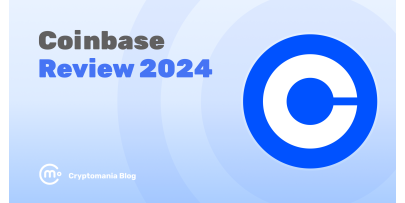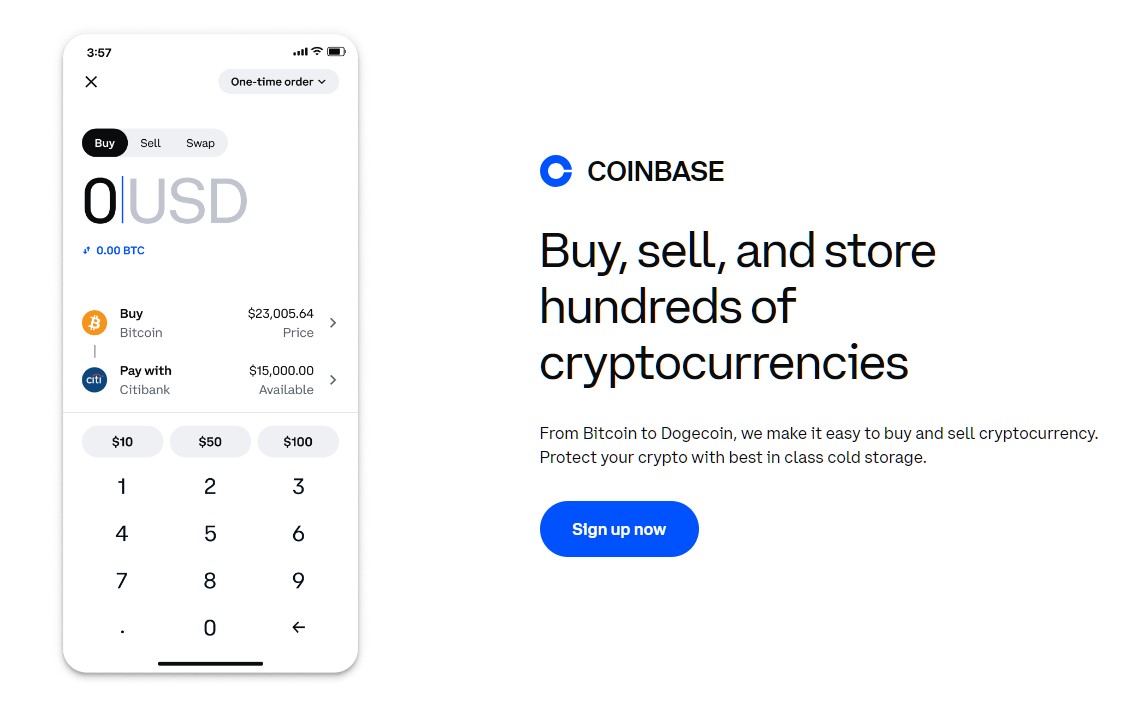

In our Coinbase review, we’ll explore one of the largest and most popular crypto exchanges, handling over 250 cryptocurrencies. Coinbase is easy to use, lets you buy crypto with a click, and accepts many payment methods. But, it’s got some downsides too — like high fees and not-so-great customer service.
Let’s take a closer look at these aspects to give you a clear picture of what Coinbase is all about.
| 👍Pros | 👎Cons |
| Low minimum requirement to fund your account | Poor customer service |
| Beginner-friendly interface | High transaction fees compared to other platforms |
| Quick crypto withdrawals | High fees for card-based deposits |
| 250+ cryptos available to trade | Controls users’ private keys |
| Passive earning opportunities on more than 100 assets | Limited staking selection |
Coinbase features and benefits
Coinbase is a great choice for cautious new investors looking for safety. As you gain experience in crypto trading, you’ll find even more reasons to stick with Coinbase.
Coinbase offers over 35 products tailored for individuals, developers, and businesses. Each product is designed for a specific audience, providing a unique trading experience.
Besides the exchange itself, Coinbase One, Coinbase Wallet, and Coinbase Advanced Trade are the best options to consider.
Coinbase Trading

Coinbase provides access to over 250 cryptocurrencies, including top ones like BTC, ETH, SOL, and ADA.
You can use Coinbase through its website or the Coinbase exchange app, available on App Store and Google Play for convenient trading on the go. To get started with Coinbase, simply link your bank account to complete the setup. This linked account enables you to deposit cash into your Coinbase account or convert your crypto to cash within minutes.
When it comes to depositing cash, Coinbase supports ACH bank transfers, debit cards, and wire transfers. What sets Coinbase apart is its support for PayPal deposits and the ability to purchase crypto using your PayPal balance.
ACH transfers are free but can be slow due to settlement times. Debit card transactions incur a fee of 3.99%, while PayPal deposits have a fee of 2.5%.
For trading, Coinbase offers a quick trade feature similar to other crypto exchanges, allowing you to buy and sell easily. However, keep in mind that these simple trades come with higher fees compared to using Coinbase Advanced, which we’ll discuss shortly.
Let’s review the fees for basic trades.
| Purchase Amount | Transaction Fees |
| Up to $9.99 | $0.99 |
| $10 up to $24.99 | $1.49 |
| $25 up to $49.99 | $1.99 |
| $50+ | $2.99+ |
Some users have noticed that Coinbase fees can be less predictable for amounts exceeding $75, as they switch to a fixed dollar amount that’s approximately 4%. However, there are instances where trades are charged at a lower fee, even if the trade amount crosses into the next tier. This may seem a bit confusing at first, but it’s part of Coinbase’s beginner-friendly approach, albeit with higher fees.
Additionally, Coinbase includes a spread in its quoted prices, which is a common practice among many exchanges to secure a specific price. This means you’re not directly interacting with the order book, as Coinbase provides a price that includes this spread.
For those looking to save on Coinbase trading fees, using Coinbase Advanced is recommended. This option doesn’t involve a spread and offers significantly lower fees, providing a cost-effective solution for traders.
Coinbase Advanced

Coinbase Advanced is a native trading platform designed for experienced users seeking enhanced tools and security for their trades. This platform offers access to real-time order books, marking a significant upgrade from Coinbase Pro, the previous advanced trading platform. Compared to the old Pro platform, Advanced Trade boasts more market pairs, integrates with TradingView for charting, and provides better staking rewards.
Coinbase Advanced offers:
- Competitive trading fees. Easily trade across 550+ markets with low, volume-based fees. There are no monthly fees or minimum portfolio sizes.
- Powerful trading tools. Access TradingView charts, advanced order types, and APIs for efficient trading executions.
- Staking rewards. When you’re not actively trading, you can earn 5% rewards simply by holding USDC. Additionally, you can stake your ETH, ADA, SOL, ATOM, or XTZ to earn up to 10% APY. It’s worth noting that fees may vary for some users. All users can review estimated fees before placing an order.
- Advanced security. The platform prioritizes security and encryption in its technology infrastructure.
- Unified balance. Users can access all Coinbase features using one balance on a single platform.
These features make Coinbase Advanced Trade a compelling option for traders looking for advanced tools, security, flexibility, and lower fees in their crypto trading journey. Compared to Simple trades, fees are significantly reduced on Coinbase Advanced.
Coinbase uses a tiered system for its maker and taker fees. This means that users who trade with larger volumes pay lower fees. Here are the tier-based maker and taker fees on Coinbase:
| 30-Day Trading Volume | Maker | Taker |
| Less than $1k | 0.60% | 0.80% |
| $1k-10k | 0.35% | 0.55% |
| $10k – $50k | 0.25% | 0.40% |
| $50k – $500k | 0.15% | 0.25% |
Coinbase Wallet

Let’s talk about Coinbase Wallet, a separate product worth highlighting. With Coinbase Wallet you can store and manage all of your crypto, NFTs, and multiple wallets in one place and also, buy crypto on the go. Wallet is integrated into the Coinbase mobile app, making it convenient for web3 interactions.
It’s a great option for those who prefer a dynamic and portable platform. Unlike the exchange, Coinbase Wallet is a self-custody crypto wallet, meaning you must keep your login details secure to avoid losing your assets permanently.
Coinbase Smart Wallets
Coinbase has just launched a revolutionary new feature: a smart wallet that’s loaded with impressive capabilities.
Here’s what makes it stand out:
- Instant wallet creation: You can create a new wallet in any dApp using just a passkey, like Face ID. No extra app downloads, extensions, or seed phrases needed.
- Fully portable: Manage your balances across platforms and use the wallet in thousands of EVM-compatible dApps already integrated with the Coinbase Wallet SDK.
Why is this exciting? Imagine sending Bitcoin or Ethereum to a friend as easily as sending a Venmo payment. No more complicated addresses or long processes — just type, send, and it’s done.
Coinbase is making crypto transactions easier for everyone, even beginners. By simplifying the process, Coinbase is helping cryptocurrencies become a part of everyday life.
This new feature is a big step forward in combining finance with everyday technology, showing how blockchain can change the way we handle money.
As of June 2024, smart wallets are only available on the testnet, but Coinbase says they will be available on the mainnet later this quarter.
Coinbase One

Coinbase One is a subscription service that allows you to buy and sell cryptocurrencies without any trading fees, although there are some limitations. By subscribing to Coinbase One, you can enjoy benefits like boosted staking rewards, priority support, and more.
The monthly cost for Coinbase One is $30.
Coinbase Staking
Staking is a method to earn rewards by holding onto specific cryptocurrencies like Ethereum, Tezos, Cosmos, Solana, Cardano, and more. When you stake your holdings, you can earn rewards gradually over time.
Staking on Coinbase is a good option. According to their SEC filing, Coinbase doesn’t lend or use your crypto as collateral. The main risk is Coinbase going bankrupt, but that’s unlikely. However, the Annual Percentage Yield (APY) for staking on Coinbase might not be as high as what you can get with decentralized staking services.
| Crypto | APY |
|---|---|
| ETH | 6.00% |
| ADA | 2.00% |
| SOL | 2.4% |
| ATOM | 6.12% |
| XTZ | 3.19% |
There are two main ways to earn on Coinbase:
1. Staking. You can stake popular cryptocurrencies like SOL or ETH on Coinbase. They even offer liquid staking for ETH.
2. DeFi Yield. Depending on where you are, you might be able to earn yields on decentralized finance apps (dApps) like Curve or Aave using Coinbase. In the US, though, this option might not be available.
Coinbase makes staking simple, but there are background fees that affect your overall yield. These fees can be a bit tricky to find and may change. If you’re looking for the best staking yield, make sure the advertised rate includes any validator fees, so you’re comparing the right numbers.
Other Coinbase features
Apart from its most popular features, Coinbase provides various other opportunities to enhance your trading experience. Here are some examples:
Learning rewards. Earn free crypto by learning about newly launched tokens. Complete a simple quiz (or three) and receive free crypto directly to your Coinbase account.
Coinbase Card. Get a new monthly reward and earn crypto on your purchases with the Coinbase crypto-funded debit card.
Coinbase NFT. It’s a social marketplace where you can showcase, buy, and sell NFTs.
It’s important to note that Coinbase NFT doesn’t store your NFTs. Instead, the blockchain where your NFT is located stores them, while your wallet address and private keys give you access and control over your NFTs.
Also, users can only buy and sell NFTs on the Ethereum blockchain, and they’ll need ETH in their accounts to cover the NFT’s cost and gas fees.
Coinbase fees
Below is a list of basic fees on Coinbase. To save money, it’s best to use Coinbase Advanced for trading, as the trade box on the homepage can be expensive.
| Transaction type | Coinbase fee |
| Coinbase basic trading | From $0.99 to $2.99 for trades up to $75, percentage-based fee for trades above $75 + spread |
| Coinbase Advanced trading |
Fees can be lower with higher 30-day trading volume. |
| Account Deposit |
|
| Coinbase Withdrawal | None. You only have to cover wire transfer — $25. |
Coinbase security
Coinbase makes sure your account stays secure using different methods. One important feature is the mandatory 2-factor authentication (2FA) system, which adds an extra layer of security. However, you should still be vigilant and take steps to protect against any unauthorized access to your account.
The exchange has two main security measures to keep customer assets safe: cold storage and multiparty computation (MPC). Most of your assets are stored offline in secure locations, while the rest online are safeguarded with MPC. With MPC, keys for any transaction are split into parts, making it incredibly difficult for attackers to steal your crypto by combining all the keys.
Here’s a quick overview of some other security measures and features Coinbase offers:
- Coinbase vaults. You can activate vaults on Coinbase, which move your crypto to a different wallet that limits withdrawals to specific users. Any unauthorized withdrawal requests are automatically canceled.
- 1:1 crypto asset backing. Coinbase doesn’t use your crypto; they store it securely. You can trade, hold (HODL), or stake your crypto. Coinbase charges fees for these activities, which is how they operate.
- Public financial records. As the largest publicly traded crypto exchange, Coinbase’s financial information is available in SEC filings if you need it.
- FDIC Pass-Through insurance. Your cash deposits on Coinbase are insured up to $250,000 per account with FDIC coverage through their partner banks. This adds an extra layer of protection for your funds.
Customer service
Many people who use Coinbase have problems with getting help from their customer service. The main complaints are that it’s hard to talk to a real person and that they take a long time to respond. You can reach out to their customer service through live chat, social media, or a ticketing system, but these options are more like doing things yourself rather than talking to someone directly.
On Trustpilot, Coinbase has received a lot of bad reviews from customers, with a score of only 1.5 out of 5 stars from over 9,350 reviews. This shows that there are big issues with how users and the platform communicate with each other.
Final thoughts
Coinbase makes investing in cryptocurrency easier by simplifying the technicalities found in many other exchanges. You don’t need to navigate complex steps to get started.
Here’s what makes Coinbase stand out:
- It offers a wide range of cryptocurrencies to choose from.
- Buying crypto is as simple as clicking a few buttons.
- There are multiple payment options available.
While some people talk about high fees with Coinbase, it’s not entirely accurate. Coinbase’s fees can vary depending on how you pay. Yes, Coinbase discloses fees before you make a transaction, but finding them upfront can be tricky. Coinbase’s fees can vary depending on how you pay, and they’re not always easy to understand.
Also, Coinbase also provides valuable features like educational videos and quizzes to help you learn about crypto trading. Plus, you can earn some free crypto along the way.





